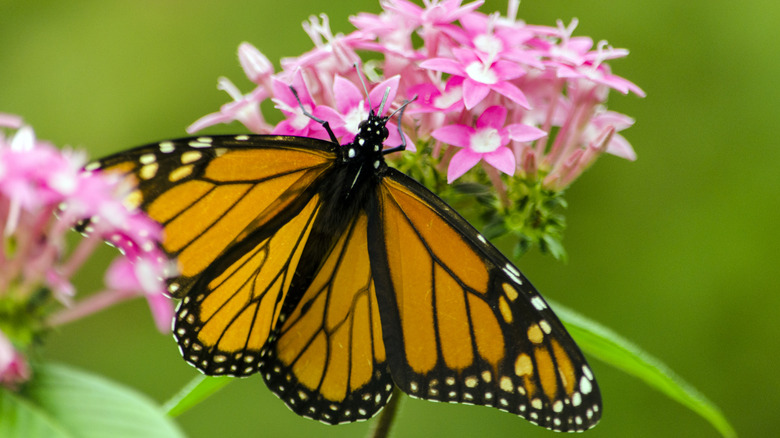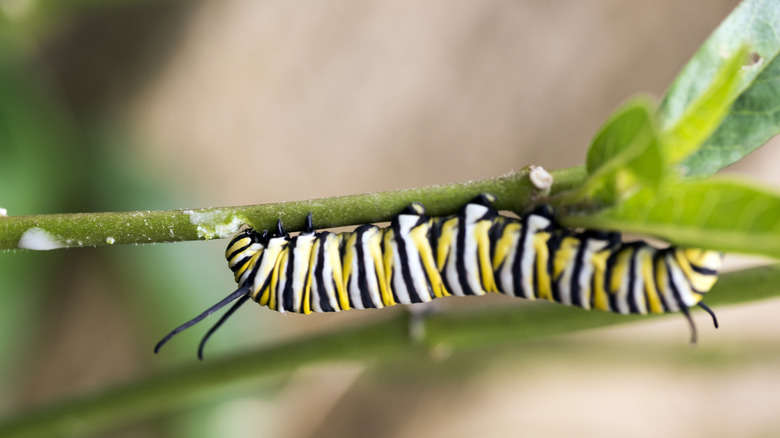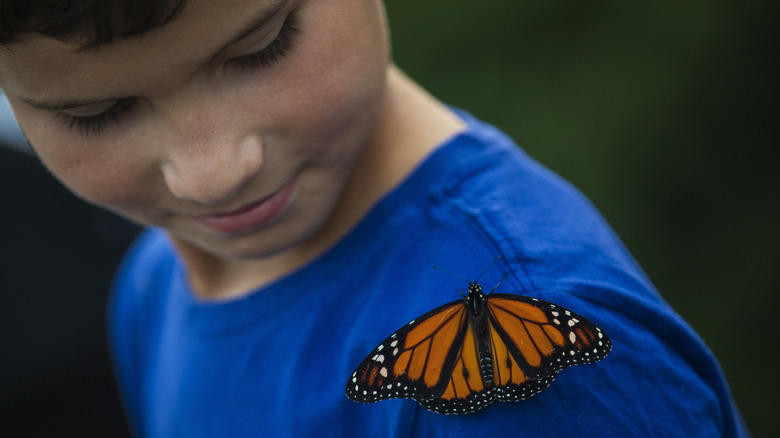Why This Is The Only Plant Monarch Butterfly Caterpillars Can Eat
Monarch butterflies are the iconic butterfly. It's impossible not to picture their vibrant orange and black wings fluttering through gardens or meadows when someone mentions them by name. These recognizable insects are celebrated for their long migrations, traveling thousands of miles between breeding grounds in North America and overwintering sites in Mexico. Yet, despite their remarkable resilience and beauty, monarch butterflies have a surprisingly fragile dependency: their caterpillar forms can only eat one type of plant — milkweed.
Milkweed is not just any plant; it's the lifeline for these caterpillars. Milkweed is a perennial with broad leaves and clusters of colorful flowers. Monarchs lay their eggs on it and, from the moment they hatch, monarch larvae feed exclusively on the plant and its leaves. The fact that these caterpillars thrive on the plant's milky latex is bizarre, considering the plant contains toxic chemicals called cardiac glycosides, also known as cardenolides.
But that's where the evolutionary relationship these two have comes into play. While these substances are typically deadly to herbivores, monarch caterpillars have developed a resistance to this toxin, and in an evolutionary response, rather than making itself more toxic, the milkweed plant has, over time, developed the ability to repair itself quickly when it senses it's being eaten. Not only can the caterpillars consume the toxin, they also store it in their bodies, making them distasteful to predators. This turns milkweed into a powerful ally in the caterpillar's struggle to make it to adulthood. The pair's exclusive relationship is an extraordinary example of coevolution, where two species evolve together over time due to their close interaction.
Milkweed is vital for monarchs
Milkweed is critical for monarch survival because it's both the sole food source for their caterpillars and a vital component of the entire monarch life cycle. Female monarchs specifically seek out milkweed plants to lay their eggs on, strategically positioning them on the underside of leaves to provide immediate access to food once the larvae hatch.
But not all milkweed species are created equal. Monarchs tend to prefer native species like common milkweed (Asclepias syriaca) and swamp milkweed (A. incarnata). Recent research indicates that the invasive tropical milkweed (A. curassavica), when grown under warmer-than-usual temperatures, produces toxins that are too much even for the monarch to withstand (check out our list of 5 times scientists fought back against invasive species and actually won). Native species, however, don't show the same levels of toxin increase with temperatures, adding to the reasons monarchs might prefer them. Tropical varieties in temperate climates can also carry a parasite known as Ophryocystis elektroscirrha, which leads to lower rates of migration success and survival overall.
And as native milkweed habitats decline due to urbanization, agriculture, and herbicide use, monarch populations are suffering significant losses. According to figures from the U.S. Department of Agriculture, monarch numbers east of the Rocky Mountains have fallen by a staggering 90% in the last 20 years. Planting native milkweed varieties in gardens and public spaces can provide crucial pit stops for monarchs as they travel thousands of miles during their migratory journeys. But milkweed conservation isn't only about butterflies — these plants support other pollinators, like bees, too (here's what would happen if bees went extinct). An integral part of North America's ecological fabric, the plant's resilience and ecological importance make it a keystone species in maintaining biodiversity across the continent.
The future of monarch butterflies
Despite the strong connection between monarch butterflies and milkweed, the future of these iconic insects is anything but certain. As climate change and habitat loss intensify, monarch populations have plummeted in recent decades. Conservation efforts are gaining momentum, however. In recent years, government programs and community initiatives have focused on restoring milkweed habitats to support monarch populations. The U.S. Fish and Wildlife Service has partnered with various organizations to plant native milkweed species in public spaces, while local conservation groups are encouraging homeowners to grow the plant in gardens and yards. Programs like Monarch Joint Venture are actively collaborating with farmers and private landowners to establish milkweed corridors across migratory routes.
To support conservation efforts, refer to regional plant guides to identify native milkweed species in your area. Talk to local botanists and other experts to get a better idea of how to grow and care for milkweed. You can also use this helpful milkweed seed–finding tool from the Xerces Society for Invertebrate Conservation to track down a vendor in your area.
By choosing to plant native milkweed varieties and participating in local conservation initiatives, individuals can play a crucial role in supporting monarch populations. Monarchs have demonstrated resilience, but like all species on our planet that are put at risk due to biodiversity loss, they need our collective efforts to ensure their survival in a changing world. And if you find the story of butterfly–milkweed coevolution as fascinating as we do, just wait until you see butterfly wings under a microscope.


